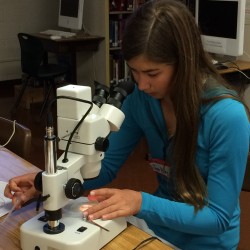Micro to Macro
Studying the Universe with New Eyes

Molokai eighth grader Gen Kikukawa looked at microorganisms in ocean water through a microscope last Saturday. Photo by Catherine Cluett
From yet-uncharted outer space life forms to swarming microscopic ocean organisms, University of Hawaii science educators shared their passion for discovery with Molokai High School teachers and students last weekend.
“It’s about giving students a window into the world of science and sharing a sense of wonder,” said Mary Kadooka of UH’s NASA Astrobiology Institute. Kadooka said she is passionate about supporting public school teachers and students with the resources they need delve into science.
To help achieve that goal, she was awarded a $50,000 grant through the Center for Dark Energy Biosphere Investigations (C-DEBI) to work with science, technology, engineering and math (STEM) programs at schools around the state. The workshops, led by a selected group of educators and researchers, introduce students and teachers to astrobiology, the search for life in the universe and microbial oceanography.
At MHS last Saturday, Sean Jungbluth of C-DEBI shared his excitement for the latest developments in space exploration and the search for life in the universe with several students and a handful of teachers.
“Think about these things not just from a scientific standpoint but with a creative mind,” Jungbluth advised Molokai youth, selected for the opportunity based on their interest and promise in STEM fields. “You never know when your crazy idea might be right.”
Kadooka said only four percent of matter in the universe is comprised of molecules we can identify. The rest is what is known as “dark” energy or matter.
“We call it dark because we have no idea what it is,” she said. “It blows my mind.”
If studying the vast unknown isn’t for them, Molokai students and teachers also got to dip into science on a smaller scale: a glimpse into the universe in a single drop of water.
Jim Foley of the UH Center for Microbial Oceanography: Research and Education (C-MORE) has helped develop kits and online resources for teachers to explore the fields of oceanography and biology. Foley shared hands-on activities using the kits’ methodology and tools.
Having gathered Molokai seawater in a fine mesh net, he placed a drop on a Petri dish under a microscope, displayed on a projector using a computer program all included in the kit.
Molokai attendees gasped as hundreds of microscopic animal organisms emerged into view, swimming in frenzied zigzags across the screen. Using identification guides, students and teachers broke into groups to draw and classify the phytoplankton and zooplankton — microscopic plants and animals, respectively — that they saw in the ocean water.
“If you like to eat fish, thank plankton. If you like to breathe, thank plankton,” said Foley, describing the role these organisms play in both the ocean food chain and the generation of more than 50 percent of the world’s oxygen.
“I want to teach this to my teacher and fellow students,” said MHS freshman and workshop attendee Lily Jenkins, sharing the air of excitement that seemed to fill the room. “It’s really good to expose them to this kind of project — they can go into their backyard and collect samples — it’s a great way to get more excited about science.”
Diane Abraham is a fifth grade teacher at Kualapu`u School who also participated in Saturday’s program. She received a $5,000 grant to take her 20 students on an overnight trip to Oahu’s Hawaii Institute of Marine Biology in April. There, they will participate in similar hands-on activities studying plankton and other marine biology. She said she’s happy she attended the program at MHS and hopes more teachers can participate in similar activities in the future.
MHS Career and Technical Education teacher Weldon Wichman agreed.
“I like challenging the kids… [and these learning opportunities] help them understand the world,” he said. After he met Kadooka at a workshop years ago, he said he took students to Honolulu for a week to work with astronomers to share limitless possibilities and opportunities available to them.
Kadooka said she has worked with several Molokai students in the past few years through summer internships.
“She has a heart for our Molokai students,” said Molokai’s Heidi Jenkins, Complex Area STEM Resource Teacher. Through Jenkins’ fostering that partnership, Kadooka, Jungbluth, Foley and others visited Molokai as part of the C-DEBI grant.
A grant from the National Science Foundation (NSF) has provided funding for scientists and UH professors to conduct several workshops on Molokai this year, said Jenkins.
“Instructors are interested in seeking out additional grants to support Molokai,” she said. “This partnership is a great beginning for future NSF grants to support our secondary teachers on Molokai.”
Kadooka said she will work within her funding to try to allocate a C-MORE oceanography kit for Molokai schools to share.
MHS’ Diane Mokuau said in the meantime, the MHS library will be able to use the kit with the microscope for several weeks. During that time, teachers and students will have the opportunity to use it during the school day, and students, parents and community members can use it during Hana Hou Tuesday and Thursday from 2 to 6 p.m. in the library.











Don't have a Molokai Dispatch ID?
Sign up is easy. Sign up now
You must login to post a comment.
Lost Password